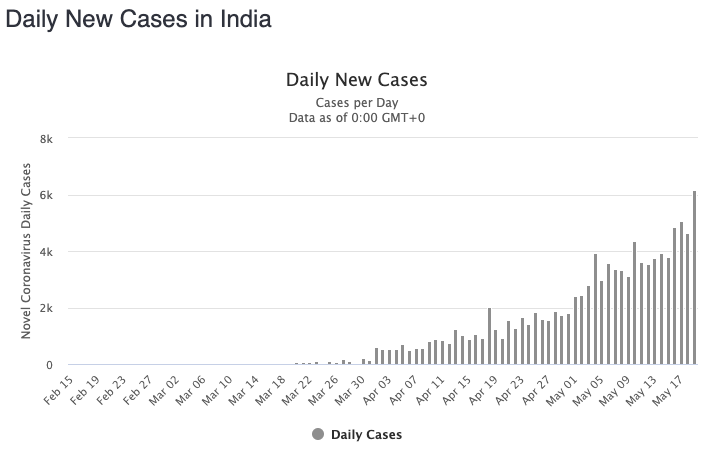Daunting numbers reveal worrying state of coronavirus around the world
While Australia continues to successfully suppress the coronavirus outbreak and begins to eye the further lifting of restrictions, the picture overseas is vastly different.
Asides from a handful of countries, which many of whom meet with Australia on a weekly basis to share details of their success, many of the world’s biggest and most powerful nations have either experienced or are on the brink of a substantial outbreak resulting in a surge in cases and ultimately deaths.
On Tuesday, Brazil, with a population of 209 million, recorded both its highest daily total of deaths and cases in one day since its first cases in February.
Brazil recorded 1,179 further deaths and 17,408 cases.
In comparison, Australia recorded just eight cases and one death – its 100th death in the entire pandemic.

“South America really needs to be looked at,” University of Queensland virologist Professor Ian Mackay told Yahoo News Australia.
“Countries within South America are really accelerating quite quickly in some places so there are lots and lots of hotspots around the world.”
Prof Mackay said worryingly for countries such as Brazil and Chile, the “worst hasn’t occurred for them yet”.
“They’re still obviously going to see deaths follow those waves of cases and obviously the more cases the higher the amount of deaths as well.”
Brazil is the latest country to surge up the coronavirus cases rankings.
It now has the third most cases in the world with 271,885.
Such a meteoric surge in cases has likely been prompted by Brazilian President Jair Bolsonaro’s lacklustre restriction measures amid the outbreak, regularly dismissing the virus as a “little flu” and placing greater importance on protecting the economy.
In recent weeks he has routinely disagreed with local governments over the implementation of restrictions.
Leading epidemiologist Professor Raina MacIntyre, from the University of NSW, told Yahoo News Australia the amount of testing, particularly in poor, high density areas could have been Brazil’s downfall.
“It is unclear how much testing has occurred and what the testing capacity and human resources capacity for contact tracing are,” she explained.
“The reported number of cases in many low income countries may be the tip of the iceberg.
“Countries that are seeing a rising trend need to review each of the pillars of disease control and also look at urban slums in megacities. These could be hot spots for transmission, where social distancing is not possible due to crowded conditions.”
Russia’s spike a big concern
One of Prof Mackay’s biggest concerns is the emergence of Russia’s wave of cases.
The nation last week became the country with the second most cases behind the USA.
“I think Russia in particular is really speeding along,” he said.
With nearly 300,000 cases, it has become Europe’s latest country – which has been ever-changing since its original epicentre of Italy – that is prompting deep concern from experts.
On Tuesday, Russia recorded nearly 9,300 new infections in 24 hours.
Trust in Vladimir Putin appears to be waning, with the president accused of offering mixed messages amid the pandemic.
Putin's approval ratings sank last month to 59 per cent, the lowest in the two decades he has been in power, Russia's independent pollster Levada Center reported.
It comes as the Russian government has been accused of manipulating its coronavirus figures, with its low death of 2,837 questioned.
However Russia strongly denies such claims, stating the reason the figure is so low is due to early management however it did admit not all deaths of people with coronavirus were being counted.

Last week, Moscow said it had ascribed the deaths of more than 60 per cent of coronavirus patients in April to other causes.
But it insisted its high case count was due to widespread testing, a move which Prof Mackay believes will assist the nation’s battle against the virus to find and isolate those infected.
Russia, alike many other countries in Europe have pushed ahead with easing lockdown measures to revive its economy despite repeated warnings cases could surge once more.
Italy and other badly-hit countries early on in the pandemic continue to display dropping case numbers, however cases are rapidly rising elsewhere.
Sweden, for example, a nation which has drawn widespread attention for its lenient restrictions, this week became the worst hit country in the continent per capita over the last week.
According to data compiled by the Financial Times, Sweden had the highest number of coronavirus deaths per capita for the past week, based on a seven-day rolling average of new deaths (per million) from May 12 to 19.
Countries need to act quicker to avoid outbreaks
Prof Mackay said it was difficult to predict if such a trend would continue in the coming weeks, where new countries continue to suffer from a spike in coronavirus cases.
“It's a hard question to answer because every country, every jurisdiction tells its own story and does things a little bit differently,” he told Yahoo News Australia.
Prof MacIntyre said she believes cases globally could worsen further in the future.
“The data from WHO situation reports show that cases are rising again, so it could be the worst is yet to come overseas,” she told Yahoo News Australia.
Prof Mackay outlined how countries without significant outbreaks so far could avoid joining the likes of Russia and Brazil, learning in part from Australia.
“I think the countries that have worked through this, and we're among those, have done lots of testing, lots of contact tracing and got down to the nitty gritty on this very early on,” he said.
The pub feed returns: How state's pubs and clubs can open this Friday
'Spells trouble': Hidden threat as restaurants, pubs and cafes start to open
“They shut the borders, they saw things coming within the first hundred cases or so and made these changes and said, ‘we have to act quickly’.”
He credits Australia for acting early and implementing its pandemic plan for avoiding a larger outbreak, which was aided by not having any land borders.
“Because all of our cases came from overseas and we don’t have land borders that we share, we can and we did track every one of those cases and all of their contacts from the beginning,” he said.
“We got on top of it whereas other countries with borders didn't close their borders quickly or just didn't think it was a big concern or maybe had some problems with the testing early on.”
What countries are now at risk?
While Prof Mackay said it appeared cases had plateaued globally as other nations control their outbreak, others who have yet had a major outbreak are vulnerable.
He said other South American countries will need to be on high-alert to avoid similar outbreaks seen on the continent.
Prof Mackay previously identified Africa as a cause of concern and said it was still vulnerable to a large-scale outbreak.
“South Africa is still struggling for its cases at the moment. It's got plenty of cases, some of the highest numbers they've had so far,” he noted.
For other African countries, low testing rates could prove to be a problem in the future as they tackle a range of issues.
“Different parts of Africa obviously have different issues such as land capacity, poverty and population density and initially, how much would a broad virus travel there,” Prof Mackay explained.
“So without lots of testing you don't know how many cases, you've got, and we're seeing that in countries that have brought their testing on later.”
Cases begin to surge in India

Another country Prof Mackay identified as “taking off” is India.
With a population of 1.3 billion, cases in India have surged past 100,000, and infections are rising in the home states of migrant workers who left cities and towns during a nationwide lockdown when they lost work.
India is seeing more than 4,000 new cases every day, with states including West Bengal, Bihar, Odisha and Gujarat — the major contributors of the migrant labour workforce in the country — showing a major spike in infections as lockdown rules were eased. More than 3,100 have died, according to India’s health ministry.
Prof MacIntyre said the nation’s high population and its level of poverty had only worsened the issue and left it prone to further spikes.
On Sunday, the federal government extended the nationwide coronavirus lockdown to May 31 but eased many restrictions to restore economic activity.

Small shops and other businesses were reopened in several states, including the capital, New Delhi, where the movement of private transport led to some traffic snarls. E-commerce companies started to deliver goods, including those considered non-essential, to places outside containment zones.
Metro service, flights, schools, shopping malls, colleges, hotels and restaurants, however, remain shuttered nationwide.
The ease in restrictions comes as the federal government gives states more control in deciding the nature of the lockdown and the power to classify areas as certain types of COVID-19 zones based on the spread and severity of cases.
And in densely populated Bangladesh, where authorities on Monday reported a record 1,602 positive tests, thousands of cars were on the streets of the capital, Dhaka, despite a lockdown that extends through to May 30.
Authorities in Bangladesh have relaxed some rules and allowed shops to open ahead of the Muslims’ biggest festival, Eid al-Fitr, at the end of the month. Public transportation is suspended but the country’s thousands of garment factories are operating.
with AP
Do you have a story tip? Email: newsroomau@yahoonews.com.
You can also follow us on Facebook, Instagram and Twitter and download the Yahoo News app from the App Store or Google Play.





